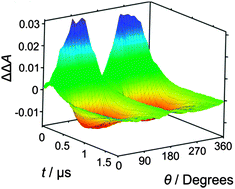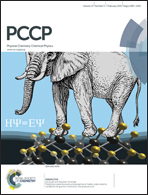Probing a chemical compass: novel variants of low-frequency reaction yield detected magnetic resonance†
Abstract
We present a study of a carotenoid–porphyrin–fullerene triad previously shown to function as a chemical compass: the photogenerated carotenoid–fullerene radical pair recombines at a rate sensitive to the orientation of an applied magnetic field. To characterize the system we develop a time-resolved Low-Frequency Reaction Yield Detected Magnetic Resonance (tr-LF-RYDMR) technique; the effect of varying the relative orientation of applied static and 36 MHz oscillating magnetic fields is shown to be strongly dependent on the strength of the oscillating magnetic field. RYDMR is a diagnostic test for involvement of the radical pair mechanism in the magnetic field sensitivity of reaction rates or yields, and has previously been applied in animal behavioural experiments to verify the involvement of radical-pair-based intermediates in the magnetic compass sense of migratory birds. The spectroscopic selection rules governing RYDMR are well understood at microwave frequencies for which the so-called ‘high-field approximation’ is valid, but at lower frequencies different models are required. For example, the breakdown of the rotating frame approximation has recently been investigated, but less attention has so far been given to orientation effects. Here we gain physical insights into the interplay of the different magnetic interactions affecting low-frequency RYDMR experiments performed in the challenging regime in which static and oscillating applied magnetic fields as well as internal electron–nuclear hyperfine interactions are of comparable magnitude. Our observations aid the interpretation of existing RYDMR-based animal behavioural studies and will inform future applications of the technique to verify and characterize further the biological receptors involved in avian magnetoreception.

- This article is part of the themed collection: Celebrating the 2016 RSC Prize and Award Winners


 Please wait while we load your content...
Please wait while we load your content...